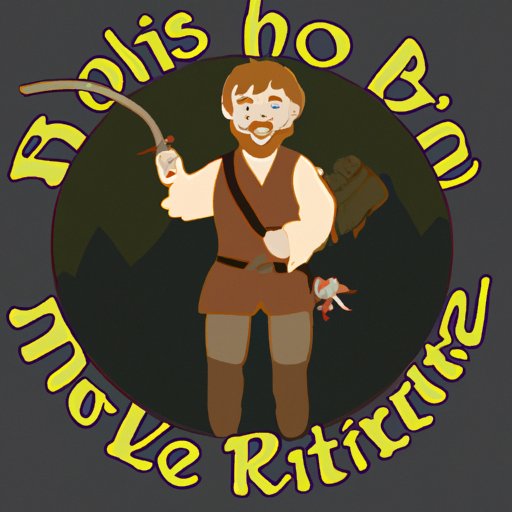I. Introduction
Many people have heard of hobbits, those furry little creatures with big feet, but not everyone understands what they are, where they come from, or why they have such a significant place in popular culture. This article aims to shed some light on these beloved creatures and explore what makes them so special. Whether you are a fan of J.R.R. Tolkien’s works, a lover of fantasy, or simply curious about hobbits, this article will offer an informative and friendly look at this fascinating topic.
II. Introducing the World of Hobbits
So, what exactly is a hobbit? Hobbits are a fictional humanoid race created by J.R.R. Tolkien. They are characterized by their small stature, furry feet, and love of food, drink, and comfort. The most noteworthy hobbits are those from The Shire, a region of Middle-earth where hobbits prize simplicity above all else. They are suspicious of outsiders but fiercely loyal to their friends, family, and community.
Within the world of Middle-earth, there are three distinct hobbit races: Harfoots, Stoors, and Fallohides. Harfoots are most common and live in burrows, while Stoors are more inclined to outdoor life and trade. Fallohides are the tallest and rarest of the hobbits with a love of trees and natural beauty.
III. Hobbits: An Exploration into the Creation, Meaning, and Popularity of Tolkien’s Beloved Creatures
J.R.R. Tolkien was inspired to create hobbits after seeing the countryside near his home in England. He imagined hobbits as a small, peaceful people who treasured the simple life. Behind the whimsy and charm of hobbits, there is a deep symbolism that reflects the real-world cultures that inspired Tolkien’s imagination. He drew inspiration from English, Scandinavian, and Celtic folklore to create the hobbits’ culture, dress, and language. Hobbits are also a commentary on the changes in society and the perils of industrialization.
The popularity of hobbits can be attributed to their relatable qualities and the enduring themes present in Tolkien’s works. Hobbits represent a spirit of community, tradition, and courage that has resonated with readers for decades. The Lord of the Rings trilogy brought hobbits to the mainstream audience, cementing their place in pop culture as endearing and relatable characters.
IV. The Journey of a Hobbit: From the Shire to Mordor, a Reflection on the Bravery and Determination of Hobbits
Hobbits play a crucial role in The Lord of the Rings trilogy, acting as a moral compass for the other characters and demonstrating the power of determination and bravery. Hobbits are called upon to journey from their home in The Shire to the heart of Mordor, where they must destroy the One Ring to save Middle-earth. Along the way, they confront numerous challenges, from treacherous terrain to deadly foes.
What is inspiring about hobbits is their determination to face these seemingly insurmountable challenges. Despite their small size and unassuming demeanor, hobbits prove themselves to be as brave and capable as any of the other creatures in Middle-earth. By the end of the trilogy, hobbits have become unlikely heroes, showing readers the value of perseverance and the power of a strong spirit.
V. The Cultural Significance of Hobbits: An Examination of How Hobbits Reflect Real-World Cultures and Why They Resonate with Readers
The cultural significance of hobbits lies in their reflection of real-world values and traditions. They are a representation of the values that Tolkien held dear, such as a love of nature, a reverence for tradition, and a steadfastness in the face of adversity. Hobbits are also relatable, with their love of food, drink, and warmth, making them an appealing contrast to the epic journey they undertake. Readers identify with hobbits’ struggles and are inspired by their resilience, making them an enduring symbol of hope and perseverance.
VI. Hobbits in Pop Culture: A Look at How Hobbits Have Influenced Other Works of Fiction and Media
The influence of hobbits can be seen throughout popular culture, making them an iconic figure. Books, movies, and video games have all drawn inspiration from hobbits and the world of Middle-earth. The success of The Lord of the Rings trilogy paved the way for other fantasy films and opened up the genre to a wider audience. Even in contemporary media, hobbits and their traits are recognizable and familiar to audiences.
The impact of hobbits on other works of fiction cannot be overstated. They have influenced the creation of many other creatures and races of fantasy, helping to shape the genre as we know it today. Hobbits have become synonymous with the fantasy genre, evoking feelings of comfort, whimsy, and adventure in readers and viewers alike.
VII. Conclusion
In conclusion, hobbits are a beloved and enduring symbol of resilience, bravery, and community. J.R.R. Tolkien’s creation of these fictional creatures has had a significant impact on popular culture, inspiring countless other works of fiction, film, and art. Their relatable qualities and enduring themes resonate with readers of all ages, solidifying their place as one of the most iconic figures in fantasy literature and pop culture. By exploring the world of hobbits, we have gained new insight into our own world and the values that we hold dear.
